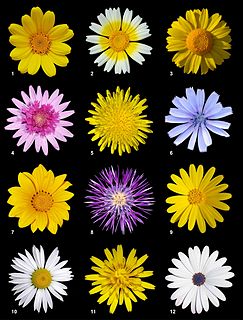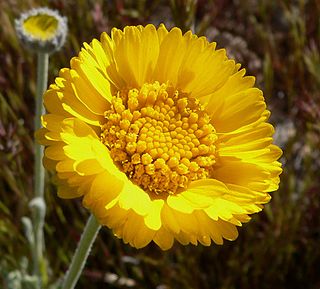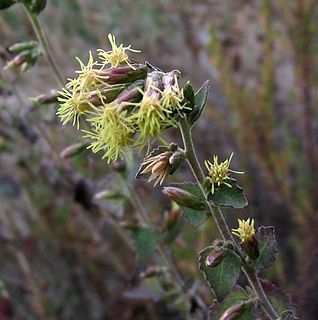
Asterales is an order of dicotyledonous flowering plants that includes the large family Asteraceae known for composite flowers made of florets, and ten families related to the Asteraceae. While asterids in general are characterized by fused petals, composite flowers consisting of many florets create the false appearance of separate petals.

The family Asteraceae, alternatively Compositae, consists of over 32,000 known species of flowering plants in over 1,900 genera within the order Asterales. Commonly referred to as the aster, daisy, composite, or sunflower family, Compositae were first described in the year 1740. The number of species in Asteraceae is rivaled only by the Orchidaceae, and which is the larger family is unclear as the quantity of extant species in each family is unknown.

Silphium is a genus of North American plants in the tribe Heliantheae within the family Asteraceae.

Erigeron is a large genus of plants in the family Asteraceae. It is closely related to the genus Aster and the true daisy Bellis. The genus has a cosmopolitan distribution in dry, mountainous areas and grassland, with the highest diversity in North America.

Xanthium (cocklebur) is a genus of flowering plants in the tribe Heliantheae within the family Asteraceae, native to the Americas and eastern Asia and some parts of south Asia.

Gundelia is a low to high (20–100 cm) thistle-like perennial herbaceous plant with latex, spiny compound inflorescences, reminiscent of teasles and eryngos, that contain cream, yellow, greenish, pink, purple or redish-purple disk florets. It is assigned to the daisy family. Flowers can be found from February to May. The stems of this plant dry-out when the seeds are ripe and break free from the underground root, and are then blown away like a tumbleweed, thus spreading the seeds effectively over large areas with little standing vegetation. This plant is native to the eastern Mediterranean and the Middle-East. Opinions differ about the number of species in Gundelia. Sometimes the genus is regarded monotypic, Gundelia tournefortii being a species with a large variability, but other authors distinguish up to nine species, differing in floret color and pubescence. Young stems are cooked and eaten in the Middle-East and are said to taste like a combination of artichoke and asparagus. The plant also contains compounds that have been demonstrated to be effective against a range of ailments. A large quantity of pollen assigned to Gundelia has been found on the Shroud of Turin, which may suggest that the crown of thorns was made from Gundelia, but this finding has been contested.

Glebionis segetum is a species of flowering plant in the family Asteraceae, probably native only to the eastern Mediterranean region but now naturalized in western and northern Europe as well as China and parts of North America. Common names include corn marigold and corn daisy.

Coriaria is the sole genus in the family Coriariaceae, which was described by Linnaeus in 1753. It includes 14 species of small trees, shrubs and subshrubs, with a widespread but disjunct distribution across warm temperate regions of the world, occurring as far apart as the Mediterranean region, southern and eastern Asia, New Zealand, the Pacific Ocean islands, and Central and South America.

Liatris, commonly known as gayfeather, is a genus of flowering plants in the tribe Eupatorieae within the family Asteraceae native to North America. Its most common name is blazing star. Some species are used as ornamental plants, sometimes in flower bouquets.

The Heliantheae are the third-largest tribe in the sunflower family (Asteraceae). With some 190 genera and nearly 2500 recognized species, only the tribes Senecioneae and Astereae are larger. The name is derived from the genus Helianthus, which is Greek for sun flower. Most genera and species are found in North America and South America. A few genera are pantropical.

Vernonia is a genus of about 350 species of forbs and shrubs in the family Asteraceae. Some species are known as ironweed. Some species are edible and of economic value. They are known for having intense purple flowers. The genus is named for the English botanist William Vernon. There have been numerous distinct subgenera and subsections named in this genus, and some botanists have divided the genus into several distinct genera. For instance, the Flora of North America recognizes only about twenty species in Vernoniasensu stricto, seventeen of which are in North America north of Mexico, with the others being found in South America.

Baccharis is a genus of perennials and shrubs in the aster family (Asteraceae). They are commonly known as baccharises but sometimes referred to as "brooms", because many members have small thin leaves resembling the true brooms. They are not at all related to these however, but belong to an entirely different lineage of eudicots. B. halimifolia is commonly known as "groundsel bush", however true groundsels are found in the genus Senecio.

Baileya is a genus of plants in the aster family Asteraceae. All are native to the southwestern United States and to Mexico.

Ericameria is a genus of North American shrubs in the family Asteraceae.

Heterotheca, are North American plants in the family Asteraceae.

Brickellia is a North American genus of about 100 to 110 species of plants in the family Asteraceae, known commonly as brickellbushes. They are found in Canada, the United States, Mexico, and Central America. Many species are native to the American southwest, especially Texas. Brickellia is among the more basal lineages of the Eupatorieae and should not be assigned to a subtribe pending further research.

Symphyotrichum lateriflorum is a species of flowering plant in the aster family (Asteraceae). Commonly known as calico aster, starved aster, and white woodland aster, it is native to eastern and central North America. It is a perennial and herbaceous plant that may reach heights up to 120 centimeters and widths up to 30 cm (1 ft).

Verbesina encelioides is a flowering plant in the family Asteraceae. The species is native to many parts of the United States and Mexico. It is naturalized in other parts of North America, the Middle East, Spain, Argentina, Australia and the Pacific islands. Common names include golden crownbeard, gold weed, wild sunflower, cowpen daisy, butter daisy, crown-beard, American dogweed and South African daisy.

Eclipta is a genus of flowering plants in the family Asteraceae.

Didelta spinosa (L.f.) Aiton, belonging to the family of Asteraceae, is a Southern African woody shrub or small tree endemic to the West Coast and found from Saldanha Bay in the south across the Gariep into the south-west corner of Namibia. Growing 2–3 m tall and drought-resistant, its preferred habitat is on dry, rocky slopes. This species was introduced to Europe by Thunberg and Masson.



















